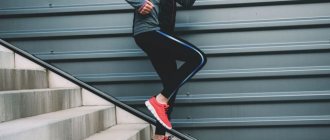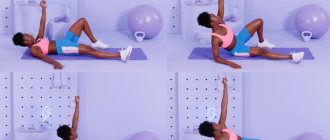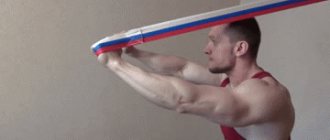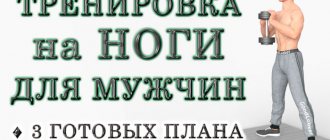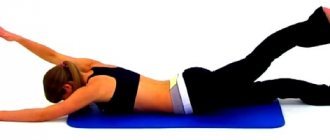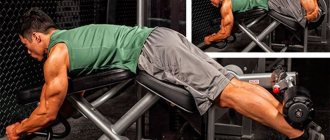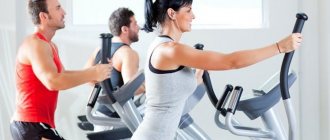Gluteal bridge
Leada Malek / Popsugar.com
“The glutes play an important role in stabilizing the knees and helping to strengthen the core,” Malek said.
- Lie on your back with your knees bent.
- Tuck your tailbone and lift your hips, pressing your heels into the floor and squeezing your glutes. Use your hip muscles to move, not your back.
Perform 3 sets of 10 reps with 30-second breaks.
see also
4 Pro Tips to Make Training Easier for People with Bad Knees
Single leg glute bridge
Leada Malek / Popsugar.com
If you're looking for an advanced version of the classic glute bridge, try this exercise. “It’s great for those who have muscle imbalances – one side is more developed,” explains the physiotherapist.
- Tighten your tailbone and, resting the heel of one foot on the floor, lift the other leg up.
- Keep your pelvis level, but use your glutes to move.
Perform 3 sets of 8 reps with 30 seconds rest.
Repeat the same with the other leg. But if you just want to strengthen your sore knee, do the exercise on one side only.
Set of exercises
There are a huge number of exercises for pumping the buttocks. But many of them involve the knees. Therefore, people suffering from knee joint diseases are not able to use them. There are a number of activities for them that will help reduce or completely eliminate the load on the knees.
Cardio
An elliptical exercise is great for warming up without putting stress on the affected area. When performing the exercise, the entire load is shifted from the knees to the buttocks. You need to pull your butt back, tilt your torso slightly forward, and when moving, press not on your toes, but on your heels.
Rotations
To perform the exercise, place a fitball or other large object in front of you and try to go around it with your legs one at a time. This will help reduce stress on the patella while maintaining quadriceps tone. A support is used for stability.
Swing lying on your side
Leada Malek / Popsugar.com
“This exercise targets one of the most important muscles for stability, the gluteus medius,” Malek said. –Although the exercise fully engages the glutes, this muscle is more effective at increasing hip strength, which in turn improves knee stability. Plus, it's a good way to work your glutes without putting any stress on your sore knees.”
- Lie on your side, bend your lower leg at the knee.
- Straighten your upper leg, contracting your quadriceps, move it slightly behind your torso, and pull your toes toward you.
- Use your gluteal muscles to move up and down rhythmically.
Perform 3 sets of 10 reps with 30 seconds rest.
Repeat the same with the other leg. But if you just want to strengthen your sore knee, do the exercise on one side only.
see also
12 exercises that can help with back pain
Swing on the floor
Another exercise for the buttocks without stress on the knees looks very good as a finishing maneuver. It is mainly aimed at giving shape to the gluteus minimus and gluteus medius muscles.
Execution: lie on a flat surface on your left/right side and stretch your legs, one hand is at chest level on the floor, and the other elbow serves as a support. The straightened leg is abducted with maximum upward swing, as far as the physical compliance of the hip joint allows. The lower leg can be slightly bent to avoid swaying back and forth. Next, the leg returns to its original position.
10-15 repetitions, 2 sets.
Important details:
- by lowering the working leg, you can move it forward slightly, which will provide better stretching of the buttocks; and when lifting, slightly back, which will give a better contraction of the muscle.
Hip extension lying on stomach
Leada Malek / Popsugar.com
This exercise increases glute strength and strengthens the hamstrings.
- Lie on your stomach and tuck your tailbone.
- Using your buttocks, lift one leg and lower it slowly.
Make sure that when you lift your leg, there is no deflection in your lower back.
Do 3 sets of 12 reps with 30 seconds rest.
Repeat the same with the other leg. But if you just want to strengthen your sore knee, do the exercise on one side only.
The benefits of aerobic exercise.
If you experience pain in your knees, you should postpone running and jumping. Active dances such as samba or zumba also put stress on the knees, moreover, they are dynamic, and sudden movements are best avoided. Aerobics and trampoline exercises will also have a negative impact on your knees.
You can strengthen and pump up your legs not only in the gym. Swimming provides an excellent workout for the entire body. Water is great for avoiding tension in the knees, while all the muscles in the body are engaged. Whether it's water aerobics or swimming, it doesn't matter, the effect will be incredible.
Bridge
Aerobic exercises include Nordic walking. It replaces running, provides a high level of activity, strengthens the leg muscles and does not put pressure on the knees and feet. In addition, the hands are actively involved. Training on a bicycle, elliptical and cycle has a good effect on the leg muscles.
In pursuit of a beautiful body, do not forget about health. Practice correctly, pay attention to the technique of doing the exercises, then the result will not take long to arrive.
Standing Hamstring Curls
Leada Malek / Popsugar.com
This is an isolation exercise for the hamstrings—strengthening them is important for increasing knee strength and stability.
- Stand straight, place your legs parallel to each other.
- Tuck your tailbone slightly and squeeze your buttocks, then bend one knee.
- Return to the starting position by touching your toe to the floor.
Do 3 sets of 8 reps with 30 seconds rest.
Repeat the same with the other leg. But if you just want to strengthen your sore knee, do the exercise on one side only.
Strength training
When performing any exercises (especially with weights), it is very important to monitor the technique: the knee is aligned with the foot, there is no rotation in the joint. Among the safest, experts note:
*Bending and extending legs in a crossover. “In this case, the load seems to stretch the joint. That is, the leg muscles are actively working, but there is no axial load on the knee,” says Alexey Fedorov.
*Legs abducted to the side (from standing and lying positions). “Here it is important to choose the right working weight,” comments Alexey Fedorov. “It should be such that you can do a maximum of 10-12 repetitions without experiencing pain or discomfort.”
*Calf raises with support.
*Straight leg raise from a sitting position.
If you have knee problems, you will have to exclude some exercises from your workout. “You should avoid exercises during which the articular surfaces may shift relative to each other, for example, turning the body with a fixed foot, and minimize exercises on an unstable platform, bosu, ball, etc.,” says Danna Gudkova , sports doctor, Head of Sports Medicine and Rehabilitation Group and Hard Candy Fitness.
But you shouldn’t give up lunges and squats, which are often banned. “They can injure your knees if performed incorrectly. However, these are the most physiological movements, there is no need to exclude them, you need to learn how to perform them correctly. I recommend mastering them under the supervision of a good specialist, since if you practice on your own, you will not be able to assess the correctness of the movement and its biomechanics,” says Danna Gudkova.
Half squat
Leada Malek / Popsugar.com
“Squats are a functional exercise that should be included in any workout if your body allows it,” says Malek. “The half squat is generally an easier option for people with knee pain and strengthens the quads and glutes.”
- Stand straight, place your feet shoulder-width apart.
- Keeping your back straight, do a half squat using your quadriceps.
- Push up, squeezing your quads and glutes.
Perform 3 sets of 8 reps with 30 seconds rest.
How training can be useful
A common cause of knee pain is osteoarthritis. Osteoarthritis: modern approaches to treatment is a group of diseases that affects various joint structures. It can affect any joint, but in 92% of cases it affects the knees.
Symptoms of osteoarthritis include knee pain that is relieved by rest and worsened by exercise, such as walking or descending stairs. Also in the morning you may experience stiffness and a sticky feeling in the knee.
Because of pain, people begin to avoid any physical activity. However, this only aggravates the condition, leads to excess weight gain, weakens muscles, and can cause Resistance Exercise for Knee Osteoarthritis fear of movement, anxiety and depression.
Both aerobic and resistance exercise reduce Physical Therapy Interventions for Knee Pain Secondary to Osteoarthritis A Systematic Review knee pain and improve knee function and gait.
The exercises do not affect the knee joint specifically, but strengthen the muscles around it. Strong leg muscles help support the knee, which reduces pressure and stress on the joints. Moreover, exercises performed with good technique help Resistance Exercise for Knee Osteoarthritis restore proper joint biomechanics, normalize muscle firing patterns, reduce pain and cartilage degradation.
Squat + calf raise
Leada Malek / Popsugar.com
“This exercise involves jumping, except you don't have to lift your feet off the floor,” the physical therapist explained. “A great option for those who can’t jump but want to achieve full leg extension.”
- Do the same movement as a regular half squat.
- But on the way up - at the top - stand on your toes, squeezing your buttocks and calf muscles.
Perform 3 sets of 12 repetitions with breaks of 30 seconds.
Prohibited exercises
For knees that are damaged due to injury or affected by any pathology, exercises involving deep lunges, strong leg bends, back bends, or those used to stretch the quadriceps are not allowed.
The most common exercise for the buttocks is squats. But if the knee joint is affected, they cannot be performed fully so that the angle is right. Otherwise, the knee is subjected to additional stress, creating a risk of developing a problem with the patella. It is allowed to do half squats so that the angle is 45 degrees.
Thus, if your knees hurt, you don’t give up sports. Physical activity is useful, but the set of exercises is designed taking into account dysfunction of the knee joint.
Calf raise
Leada Malek / Popsugar.com
According to Malek, you need to constantly tone your calves, one of the main muscles that cross the knee joint. It is the calf muscles that are used when pushing off while walking.
- Stand up straight, keep your knees straight.
- Smoothly transition from heels to toes, squeezing your calves.
- Don't go too high to avoid straining your muscles. Hold this position and lower yourself down.
Perform 3 sets of 12 reps with 30 seconds rest.
Osteoarthritis of the knees: what exercises are possible and not
After the publication of my letter Osteoarthritis of the knees: How to reduce pain? in the “Bulletin of Healthy Lifestyle”, of course, I was bombarded with questions “What exercises should I do for arthrosis?”
Be sure to read:
Spine and joints: treatment regimen #1
Spine and joints: treatment regimen #2
Spine and joints: treatment regimen #3
Spine and joints: treatment regimen #4
For several years now I have been diagnosed with gonoarthrosis of the knee joints. Not a single doctor or trainer could name exercises for the legs that should and should not be done for this disease. There are only abstract discussions on this topic on the Internet. And, as a rule, from people who know about arthrosis only in theory. Therefore, I had to sift through a lot of information and try it on myself in order to come to an accurate list of types of exercises. I’ll say right away that you need to strengthen all the muscles of the legs, hips and lower legs. And strengthen it thoroughly. Everything said here also applies to arthrosis of the hip and ankle joints.
Attention! Exercise is exercise, but to heal joints, you first need to nourish them with the necessary substances so that the process of regeneration and restoration begins. Otherwise, physical exercise will only make the disease worse. Sick joints need increased nutrition, especially Collagen - this is the protein that makes up cartilage. Be sure to use chondoprotectors, especially Glucosamine - this is the basis of synovial fluid.
Here you can buy Glucosamine and Collagen
WHAT YOU SHOULD NOT DO WITH ARTHROSIS
Exercises with axial load, i.e. when body weight puts pressure on the legs. Especially if you are obese:
- Run
- Jumping
- Squats and lunges
- Lift heavy weights while standing
- Leg press
- Football, basketball, etc.
- Active dancing and cardio fitness
- As for yoga, be very careful with “lotus” type asanas, where the knees are bent as much as possible
THE SIMPLE EXERCISES
The most gentle and accessible exercises: Therapeutic exercises for a sore knee
And here are joint exercises for the knees:
EXERCISES VERY USEFUL
Without axial load, when body weight does not put pressure on the legs, or is minimized. These exercises are especially good at the initial stage of strengthening the muscles responsible for the knees. You need to exercise your muscles every day. Do it for the rest of your life. If you expect to exercise a little 3 times a week, there will be no result. To cope with arthrosis, you need very strong muscles!
Exercises according to S. Bubnovsky from his book “Knees Hurt: What to do?” These are really pain-reducing exercises if you don't mess around and be patient. Exercise every day, with effort, so that the next day your muscles hurt from the load, and within a month you will feel better: Bubnovsky at home - simple! Knees.
Various other exercises for the leg muscles without axial load with a rubber band:
Swimming. Various styles. And swim using the strength of your legs, not your arms. Every day.
OTHER EXERCISES WITHOUT AXIAL LOAD
There are many such exercises. Take, for example, fitball. Here are exercises that will perfectly work not only the muscles of your legs, but also the muscles of your abs, arms, and back.
- Raising the pelvis on a fitball (the hamstrings, gluteals, calves and even quadriceps work great):
- Here is a good exercise that also works almost all the leg muscles. Drop to the floor and catch the ball with your feet at a fast pace:
- Also for the back of the thigh and buttocks. If you squeeze the ball with force, you will also work the inner thigh:
- Pulling the knees to the chest (quadriceps femoris, calves):
- Another great exercise for the front thigh:
- And if you strongly squeeze the fitball and raise your legs while lying on your side, you can work the adductors and tensor fascia lata of the thigh:
- For the soleus and gastrocnemius muscles. Keep your pelvis raised and quickly lift your heels, imitating steps. Don't tear off your socks:
EXERCISES WITH DISTRIBUTED AXIAL LOAD
When not all body weight falls on the knee joints. I recommend it if the muscles are already sufficiently strengthened. And listen carefully to your knees, if there is pain, it’s too early for you to do these exercises! Return to exercises without axial load.
- Skiing and Nordic walking (put your body more on the poles). An alternative to running.
- Bike. Ambiguous load on the knee joints. There is no axial load, but there is a load from rapid extension-flexion movements.
- Replacement of squats - squats, holding hands on a support:
- And also wall squats. Squeeze the ball with your knees and roll from heel to toe - you will work all the muscles of your legs.
- And another replacement for running is running in plank and crab pose. You can also jump in plank:
ADVICE. Use knee pads (bandages). The knee brace actually transfers part of the load from the joint to the muscles, fixes the joint, and protects the kneecap. I have a knee brace from Orlett that can be used for extreme sports. It has a lock for the kneecap and stiffening ribs on the sides, a system of perspiration and ventilation. Do not neglect orthopedic arch supports. They fix the foot in the correct position and cushion.
Spinal hernia: How to get rid of pain? Experience
Why gelatin helps, but chondoprotectors do not work
Therapeutic exercises for a sore knee
Bubnovsky at home - simple! Knees
Egg and vinegar for bones
Reality experiment: Diatomaceous earth for health
"Boat"
Leada Malek / Popsugar.com
“This exercise works all the muscles in the back of the body,” Malek explained. “A great option for working your core and hip muscles with control.”
- Lie on your stomach with your arms extended forward. Gently tuck your tailbone.
- Squeeze your glutes to lift your legs and push your shoulder blades back to lift your arms.
- Aim to lift your ribs, but keep your eyes on the ground. Avoid arching your lower back too much.
Do 3 sets of 8 reps with 30 second breaks.
How to replace squats?
Photo: istockphoto.com
Leg curls in the simulator
Technique:
- Lie down on the machine and press your pelvis firmly against the bench.
- Tighten the back of your thigh, then bend your shin to a 90-degree angle.
- Try not to lift your pelvis off the bench.
- Then slowly return your shin to the starting position.
Perform three sets of 15 reps. Rest between sets is one minute.
Leg extension in the simulator
Technique:
- Sit on the exercise machine. Press your pelvis and lower back tightly against the cushion and back of the machine.
- Tighten the front surface of your thigh, then extend your shin, slightly not bringing it parallel to the floor.
- Try not to lift your pelvis and lower back from the machine.
- Then smoothly lower your shin to the starting position.
Perform three sets of 15 reps. Rest between sets is one minute.
Leg press
Technique:
- Sit on the machine with your feet resting on the platform.
- Press your pelvis and lower back tightly against the cushion and back of the machine.
- Place your feet at the top of the platform and place them slightly wider than your pelvis, with your toes pointed to the sides at an angle of 45 degrees.
- Smoothly lower the platform to a 90-degree angle at the knees, without lifting the pelvis and lower back.
- As you exhale, squeeze the platform powerfully. Make sure your knees move in the direction of your toes.
Perform three sets of 15 reps. Rest between sets is one minute.
Photo: istockphoto.com
Gluteal bridge
Technique:
- Lie on your back, bend your knees, resting on your heels.
- Push your pelvis upward powerfully until it is in a straight line with your back, pausing at the top point for one second.
- Lower yourself smoothly to the floor for 2-3 seconds.
Perform three sets of 20 reps. Rest between sets is one minute. If necessary, use additional weights.
Hip extension in the simulator
Technique:
- Sit on the exercise machine. Press your pelvis and lower back tightly against the cushion and back of the machine.
- Place your feet on the footrest, press your shoulder blades against the back, maintaining a natural arch in your lower back.
- Exhale and spread your hips out to the sides as much as possible. Stay in this position for a second.
- Exhale and slowly return to the starting position.
Perform three sets of 20 reps. Rest between sets is one minute.
Photo: istockphoto.com
